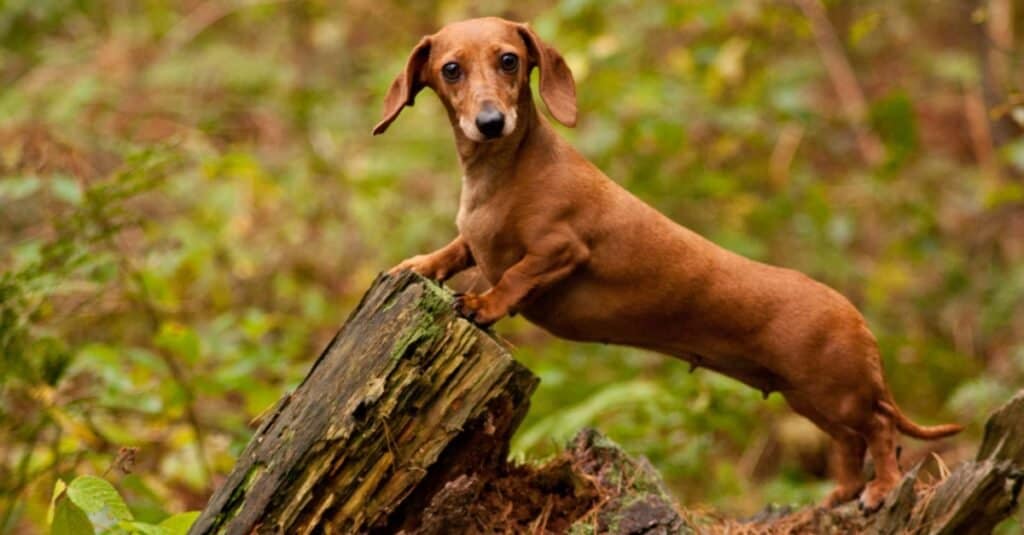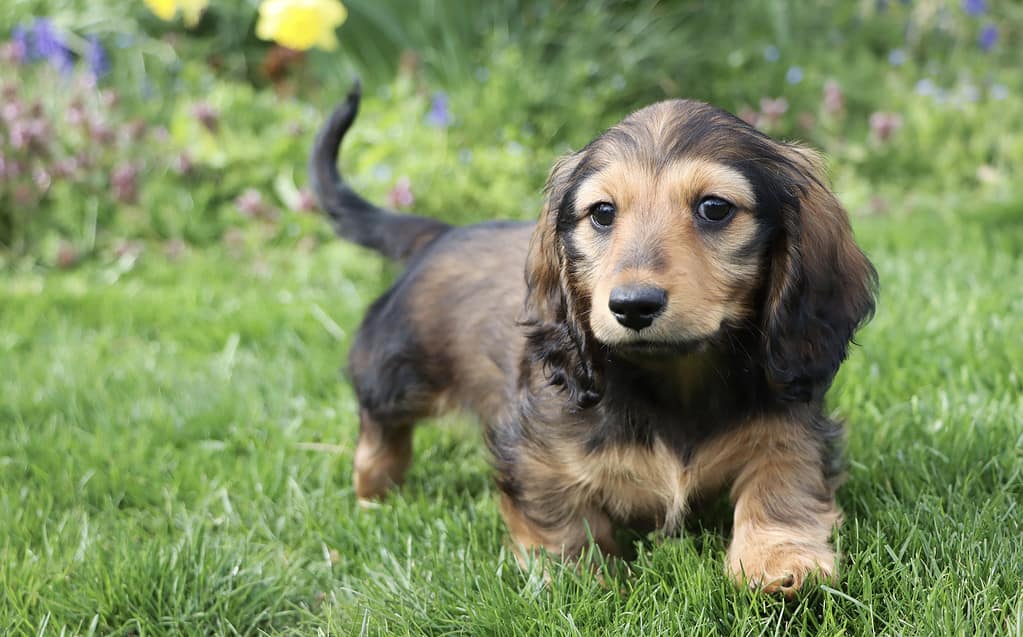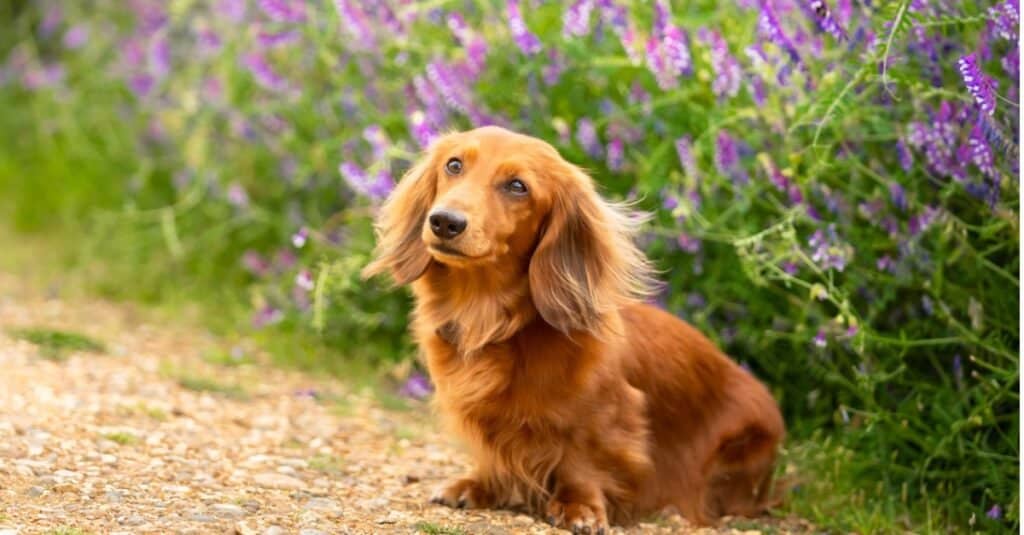Mini Dachshund Summary
Miniature dachshunds are simply smaller versions of the standard dachshund. These mini dogs weigh under 11 pounds and usually stand around 5-6 inches at the shoulder. They come in three coat types: smooth, wiry, and long, as well as many different patterns and colors. Despite being small, they have very big, determined personalities and are sometimes described as being a bit bossy.
Mini Dachshund Growth and Weight Chart by Age
| Age | Weight |
|---|---|
| 3 months | 5-6 pounds |
| 6 months | 8-9 pounds |
| 9 | 10-11 po |
When Will My Mini Dachshund Stop Growing?
Mini dachshunds are rather small, so they don’t take as long to reach their full size as some other breeds. Usually, these dogs reach their full height around nine months, but it may take a few more months for them to “fill out” and develop more muscle. Like many breeds, they tend to reach their adult height before their adult weight.
During their puppyhood, mini dachshunds should be fed quality puppy food. Because they are so small, it’s often best to feed them three meals a day to prevent problems with their blood sugar. Follow the feeding directions on the dog food package and divide how much food they need evenly across all three meals.
Regular veterinary check-ups are important to ensure your puppy is growing properly. Furthermore, your puppy will also need vaccinations several times during their first year of life. Their first vaccinations usually start around 6-8 weeks and continue for several months. Speak with your vet about the best vaccination schedule for your canine.
How Big Will My Mini Dachshund Be When It’s Fully Grown?
Typically, these canines grow to around 8 – 11 pounds. The AKC defines miniature dachshunds at less than 11 pounds, though, so they could technically be even smaller than 8 pounds. Some breeders do produce smaller dogs, but it’s important to note that very small dogs may be at a higher risk of certain health issues.
The height is more well-defined at between 5 to 6 inches from the dog’s shoulders.
Of course, there are many factors that go into how big your dog might get. Genetics plays a large role, but so does nutrition.
When Should My Mini Dachshund Be Spayed or Neutered?
When your miniature dachshund should be spayed or neutered depends largely on who you talk to. Some vets think that dogs should be spayed and neutered right away to eliminate the chance of pregnancy. Not only does this prevent overpopulation, but it also lowers the chance of a female getting pregnant before she is even done growing herself. Plus, spaying and neutering your dog may also lower the risk of certain health problems.
That said, others believe that these surgeries should wait until after the dog is done growing. Hormones produced by the sex organs do play a role in growth, and a higher risk of joint problems has been reported in dogs that are spayed and neutered early. However, these negative effects mostly only affect larger dog breeds, and the miniature dachshund obviously doesn’t fit into this category.
In the end, you’ll need to talk to your vet to determine when to spay or neuter your dog. Sometimes, breeders may require buyers to spay or neuter their dog at a younger age to prevent pregnancy, especially if you do not purchase breeder rights.
When Should My Mini Dachshund Be House Broken?

As you might expect, these dogs are extremely tiny! While this makes them cute, it also leads to difficulty with house training.
©iStock.com/NORRIE3699
Mini dachshunds are very small dogs, which also means they have a smaller bladders. For this reason, it typically takes longer for them to be housebroken. They have to go outside more, and most dog owners are simply unable to take their puppy outside every thirty minutes. Therefore, you often have to wait until these dogs start reaching their full size at around six months to complete potty training.
Once they have a larger bladder, the process is often a bit smoother. Still, as small dogs, housebreaking them is usually more challenging than it is for larger dogs. That doesn’t mean you should start potty training early, though.
You should establish a potty routine right away. Be sure to take your dog outside after meals and before bedtime. You should also take your dog outside as much as possible outside of these times. The more opportunities your puppy has to use the bathroom outside, the faster potty training will go.
Choose a designated spot where your puppy will use the bathroom every time. “Outside” can be a bit of a vague concept for puppies, so you’ll often need to narrow it down to a very specific place outside. Using the same spot will also leave behind a smell that will encourage your puppy to go there again.
Whenever your dachshund successfully uses the bathroom outside, heap on plenty of praise and treats. You want your dog to associate using the bathroom outside with positive feelings, as this will make them go there again.
Whenever your puppy is inside, supervise them closely. When you notice signs that your dog needs to use the bathroom, take them outside right away. Consider confining your dog to a smaller space when you can’t supervise them directly.
Accidents are bound to happen, especially with these small dogs. Clean up accidents right away with a powerful, enzymatic cleaner to help prevent further accidents from occurring. If a dog smells where they’ve previously used the bathroom, they’re more likely to go in that same spot again. Don’t punish your dog for having an accident. Punishment may only make them hide when they need to use the bathroom, which will make it harder to housetrain.
When Should My Mini Dachshund Stop Eating Puppy Food?
You should switch your miniature dachshund over to an adult formula after they have finished growing, which usually occurs around 8 to 9 months. That’s quite a bit earlier than other dog breeds, but it’s because small dogs tend to stop growing earlier than large dogs. Once they’re done growing, dogs no longer need the extra calories and nutrients provided by their puppy food.
If you continue their puppy food for too long, your dog may gain excess weight. Even a few extra ounces can cause health problems for a mini dachshund, especially for their back. Therefore, it’s vital that you switch them to adult food as soon as they’re done growing. You can work with your vet to figure out exactly when that is, but it should be by nine months for most mini dachshunds.
You don’t want to switch these dogs off of their puppy food too early, either. Taking away their puppy food before they’re done growing can lead to deficiencies and health problems. Puppies simply require more calories and nutrients to support their growth.
When you do decide to switch, do so gradually to prevent messing with your dog’s stomach. Slowly incorporate more of their adult food and less of their puppy food over a week or so.
When Will My Mini Dachshund Start Losing Teeth?
While they do reach their full size before other breeds, mini dachshunds start losing their teeth at around 3 to 4 months, just like any other dog breed. This process usually takes a couple of months and is completed by around six months.
Some variation in timing is completely normal. Some dogs may start losing teeth at four months, lose them quickly, and then be done at five months. Other mini dachshunds may start earlier, take a while to lose their teeth, and not be done until six months. Both are completely normal.
When your dog is teething, they may experience some pain. To alleviate this, many dogs will start to chew more. You should provide some appropriate chew toys and direct your dog to those whenever they begin to chew. Be sure your house is puppy-proof, as dogs may begin to chew on things they shouldn’t, like cords.
When Should I Start Training My Mini Dachshund?
We recommend that you start training your mini dachshund as soon as you bring them home. Whether you mean to or not, you’re constantly teaching your puppy about what is expected and okay. It’s much better to teach these things consciously rather than just accepting whatever habits develop.
For instance, you probably don’t want your dog jumping on people. Therefore, you should teach them not to jump from day one. Don’t give bad habits a chance to take hold, as they can be challenging to get rid of.
You should also start obedience training right away. However, small puppies will progress slower than they may as an adult. Despite this, it’s still important to get them used to training when they are young. Start with very basic commands and move on from there.
Once your puppy has had their first round of shots, you should start socializing them. Simply put, this involves introducing them to as many people, animals, and places as possible. You want these places to seem “normal” so that your dog isn’t fearful of them as an adult. You cannot socialize your dog too much, and socialization works best in the first few months of a dog’s life.
What Cues Should I Teach My Mini Dachshund First?
There are tons of potential cues to teach your mini dachshund. However, it makes sense to start teaching some first. Often, these cues are required to teach others, or they may just be essential for your dog’s well-being.
Here’s a list of the cues we recommend and the general order we recommend teaching them:
- Look: Before you can teach your dog any command, you must teach them to pay attention to you. This cue is commonly skipped, but it can make training your dog much easier in the long run.
- Sit: Next, you should teach your dog to “sit.” While this command is very helpful for controlling your dog, it’s also necessary for many other commands.
- Leave It: This catch-all command tells your dog to leave things alone – whether those things are the neighbor’s cat or food you dropped on the floor. It usually takes mini dachshunds a while to master this command. For this reason, we recommend you start teaching it early alongside other cues.
- Stay: This cue is a very common one, as it’s exceptionally useful for controlling your dog. However, it also teaches your dog impulse control, which can help in other portions of their life, too.
- Come: A reliable recall can be life-saving, but it’s also very hard for dogs to master. Start teaching “come” at the same time you teach “stay”. Work up to longer distances and practice in more distracting places. Just because your dog will “come” at home does not mean they’ll do it at the dog park.
- Wait: Wait is fairly similar to “stay”. However, this command works best when you’re trying to keep your dog from running out the door. It means, very simply, slow down.
When Will My Mini Dachshund Calm Down?
Mini dachshunds are somewhat active dogs, though their small legs make it easier for them to expend their pent-up energy. Like most dogs, they will have a puppy-like exuberance until they mature, which usually occurs around a year old. Until then, they may be a bit more hyperactive.
Of course, individual variation exists. Some dogs may calm down closer to 9 months, while others may take until 18 months. This process is gradual. Your mini dachshund won’t just wake up one morning and suddenly be mature.
Consistent training and socialization can help your dog learn how to behave and may speed up their maturation. A dog that isn’t well-socialized may continue to get excited and hyperactive well into adulthood. Obedience training can also help dogs with impulse control, an essential part of “growing up.” Commands like “leave it,” “stay,” and “wait” all train impulse control directly.
Be sure you provide your dog with plenty of exercise, too. A mini dachshund that isn’t provided with enough time to run around may have a harder time staying calm.
Common Health Issues Your Mini Dachshund Might Experience
These dogs are generally healthy, with a pretty long lifespan. However, they can develop a range of health issues, mostly related to their short legs and elongated back.
Intervertebral Disc Disease is exceptionally common in these dogs. It may affect as many as 25% of these dogs in their lifetime. This condition occurs when one of the discs in the dog’s back slips or bulges, cutting off the spinal column. In many cases, this condition can lead to paralysis if not promptly treated. Luckily, rest and crating the dog is sometimes the only necessary treatment, though some dogs may require medication or surgery.
Mini dachshunds are also prone to obesity. Their short stature and small legs can make it more challenging for them to exercise, increasing their weight. Many pet owners also see these dogs as lap dogs, though they were originally bred for hunting purposes. Sadly, obesity can cause a range of issues and increases the chance of back problems.
Luxating patella is common in most small breeds, including the mini dachshund. This condition occurs when the kneecap slips out of place. To compensate for the messed-up kneecap, mini dachshunds tend to walk with a “skip” in their step (a clear sign of this condition).
Pictures of Mini Dachshund as Puppies

Miniature dachshunds come in three different hair types: smooth, wiry, and long.
©Sherri Simms/iStock via Getty Images
Pictures of Miniature Dachshund at 6 Months

By six months, these dogs are practically already full grown. It can be hard to tell the difference between them and an adult.
©James Player/Shutterstock.com
Pictures of Fully Grown Miniature Dachshunds

These long-haired dachshunds are becoming more and more popular, though the smooth-coated dachshund is still one of the more popular options.
©iStock.com/romitasromala
The photo featured at the top of this post is © CBCK-Christine/iStock via Getty Images
Ready to discover the top 10 cutest dog breeds in the entire world?
How about the fastest dogs, the largest dogs and those that are -- quite frankly -- just the kindest dogs on the planet? Each day, AZ Animals sends out lists just like this to our thousands of email subscribers. And the best part? It's FREE. Join today by entering your email below.
Thank you for reading! Have some feedback for us? Contact the AZ Animals editorial team.






